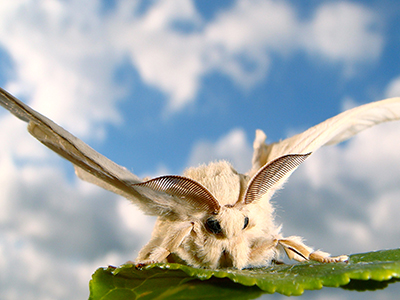The world smells different for female silkmoths than for males
In humans, the sense of smell is similarly developed in men and women, although women have slightly more olfactory neurons and therefore a slightly more sensitive nose. On the whole, however, they perceive the same odors. Male moths, on the other hand, live in a completely different olfactory world to their female counterparts. For example, the antennae of male silkmoths - their "nose" - are highly specialized to detect female sex pheromones, while females cannot even smell their own pheromones. There are thousands of sensilla on the antennae, hair-like structures, which can be divided into morphologically and functionally distinct groups. The most common sensilla in males are long and contain two sensory neurons. One is specialized to detect bombykol, the sex pheromone of females, while the other responds to bombykal, a component of the pheromone of other moth species. While bombykol is highly attractive to male silkmoths, bombykal is a deterrent.
"Because female silkmoths cannot smell their own pheromone, it was long thought that their long sensilla also have a very specific function that is only found in females. After mating, the female's only task is to find a suitable plant on which to lay her eggs. It has therefore been suggested that the long sensilla of females are specialized to detect the attractive odor of mulberry trees. We wanted to test this assumption", says Sonja Bisch-Knaden, who leads a project group in the Department of Evolutionary Neuroethology at the Max Planck Institute for Chemical Ecology.
Long sensilla of female silkmoths recognize silkworm feces
Electrophysiological methods, such as measuring the activity of individual sensilla (single-sensillum recording), were crucial for the study’s results. The scientists not only tested many different individual odors, but also natural odor mixtures, such as those found in the leaves of the mulberry tree, caterpillar droppings, the body odor of moths or the meconium, a liquid that moths secrete when they hatch. All these odors, which play an ecological role in the silkmoth's environment, had been collected. The research team was also able to match the expression of olfactory receptors to the corresponding sensillum type.
"We were surprised to find that neurons in the long sensilla of female silkmoths were not specialized to detect the odor of the host plant, as expected, but that one of the two neurons in the long sensilla is very sensitive to odors such as isovaleric acid and benzaldehyde. The detection of the odor of the mulberry leaf itself is carried out by neurons in medium-length sensilla", summarizes Sonja Bisch-Knaden.
Isovaleric acid and benzaldehyde are odor components of silkworm feces. Using a simple Y-maze test with an entrance arm that splits into two side arms through which either an odor or clean air (control) is introduced, the research team was able to elicit behavior in the otherwise immobile females that expressed attraction or aversion. Major differences became apparent when comparing virgin and mated females. The researchers showed that odors associated with caterpillar droppings did not trigger a specific reaction in virgin females, but had a deterrent effect on mated females. Presumably, the smell of feces helps females avoid mulberry trees, which are already full of silkworms when they lay their eggs.
In search of the male silkmoth pheromone
The pheromone of female silkmoths, bombykol, was chemically characterized as early as 1959 - the first insect pheromone ever. So far, scientists have not been able to identify a male counterpart. The current study provides clues, but no answers to the question of a male pheromone. "The second neuron in the females’ long sensilla is highly specific for (+)-linalool, an odor already identified as a component of the male pheromone in other butterfly species. However, no linalool could be found in the body odor of male silkmoths, and (+)-linalool alone had neither an attractive nor a repellent effect on female silkmoths in behavioral experiments", says Sonja Bisch-Knaden.
Special features of the odor perception of silkmoths
While investigating the molecular basis of odor detection in female silkmoths, the researchers noticed a peculiarity in the spatial organization of olfactory receptors. There are two families of olfactory receptors, the evolutionary older ionotropic receptors (IRs), which detect mainly acids, and the odorant receptors (ORs), which detect a wide range of chemically diverse compounds. Based on studies in the model fly Drosophila melanogaster, it was long thought that neurons expressing IRs or ORs usually occur in different types of sensilla, and that IRs never occur in long sensilla. In the silkmoth, however, an IR co-receptor for the detection of acids and the obligate OR co-receptor are both found in the same neurons located in long sensilla. This co-expression of IRs and ORs increases the chemical receptivity of the sensory neurons. Odors detected by both receptor types are processed and transmitted together, which could be advantageous for the unambiguous detection of ecologically important odor mixtures. "It is amazing that research on insect olfaction continues to produce surprising results. Our study shows that it is important to study more than just one model," says Bill Hansson, head of the Department of Evolutionary Neuroethology.
The researchers also found this co-expression of the two receptor types in the long sensilla of male silkmoths, which is why they assume that the detection of acids could also play an important ecological role in males. Further investigations will now clarify this.
Original publication
Schuh, E., Cassau, S., Ismaieel, A. R., Stieger, R., Krieger, J., Hansson, B. S., Sachse, S., Bisch-Knaden, S.
Females smell differently: characteristics and significance of the most common olfactory sensilla of female silkmoths
Proceedings of the Royal Society B: Biological Sciences, doi: 10.1098/rspb.2023.2578 (2024)


